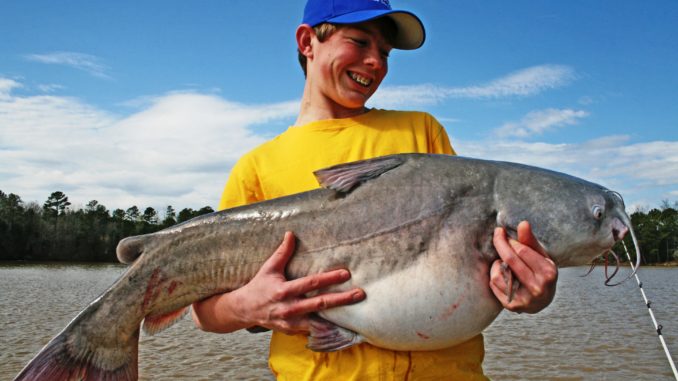
Drift cut bait for blues and channels, anchor up and fan-cast for flatheads at Lake Wylie along the North Carolina-South Carolina border.
Lake Wylie is about to wake up from sleeper status in terms of being a premier player among South Carolina catfishing lakes.
Some anglers already know about the Lake Wylie catfish connection that the rest of South Carolina’s fishermen are now discovering. The recent boom in both blue and flathead catfish productivity has increased the potential for trophy fish and added more quantity and quality to the already prolific lake.
Rodger Taylor, a catfish guide who lives on Allison Creek, a tributary on the lower end of Lake Wylie, said the boom phase has begun.
“In addition to the existing population of channel catfish that is still outstanding, we now have big and growing populations of both blue and flathead catfish,” Taylor said. “The blue and flathead populations have expanded at an exponential rate and now have populations large enough to target these species individually. When added to the channel catfish that has maintained the excellent number and size production we’ve long enjoyed, Lake Wylie is a premier catfishing lake in the Carolinas. May has always been one of my favorite months for channel catfish action and now we have blue catfish in quantity and quality as well as some big flatheads.”
Dieter Melhorn of Cramerton, N.C., is another Lake Wylie catfishing guru. While not a guide, he targets catfish on the lake as much as most anyone – 98 days in 2011 and 78 days in 2012 ,citing the unfortunate need to work more often in 2012.
“The first thing I will say about catfishing Lake Wylie during May is that the channel catfish are on fire,” Melhorn said. “The channel catfish bite by drift-fishing is tremendous, and it’s easy to load the boat with good numbers of hefty, hard-fighting channel catfish.
“As a bonus, while we’re doing that, we’re also now catching a lot of blue catfish while fishing for the channel cats. The big flatheads are occasionally caught drift-fishing, but typically we target the flatheads for best results.”
Melhorn keeps very detailed records of his catches at Lake Wylie, and all the lakes he catfishes. He said his data indicates a spike of flathead productivity from late-April and into May.
“After this spike at the end of the cold-weather, dormant season, the flatheads action slows a bit, but they will still be caught,” he said. “Good fishing exists in early May for flatheads, then the action slows for a while and spikes again when the weather gets hot.”
Taylor (803-328-9587) said the channel catfish and blue catfish will overlap in many cases in terms of where they are caught, but they can still be targeted individually as well.
“A few years ago, I could expect to make good catches of channel catfish by drift-fishing during May,” Taylor said. “Now I’ll catch a mixture of channel and blues, and the blues offer some great potential for bonus big fish in the 25-pound and larger class.
“To target channel and blue catfish, most of the action in early May will be in the major creeks,” Taylor said.
Taylor targets specific underwater structure when drift-fishing; it’s not a random, haphazard method of fishing for consistent success. He uses his electric motor to slowly move his boat along, drifting over underwater humps, along channel ledges, into deeper holes, around underwater islands and over long, sloping points: a few examples of his favored targets.
“Essentially, I am looking for any change in bottom contour as a potential key to successful catfishing,” Taylor said. “Throughout the year, catfish will orient to a diversity of structure types.”
“I slowly motor along ledges that fall into channels, around humps, off points and where feeder creeks junction the mainstream river, searching for something different along the bottom contour,” he said. “For example, if I’m graphing a drop into the channel, or better yet studying a map before I even go fishing, and for three hundred yards I see a consistent bottom feature, it doesn’t pique my interest. But if I see a high spot along the ledge or a point that juts several yards into the lake or perhaps a small ditch coursing its way across the flat to the creek or river, I’ve found a potential catfish hotspot.”
Melhorn fishes the same type of areas; most of the time he will drift in 15 to 20 feet of water in big, tributary creeks during early May. However, when drifting over a hump or ledge, he will sometimes fish shallower, just in case the fish have moved shallow to feed. Among his favored areas are Little Allison, Big Allison, Crowder’s and Beaver Dam creeks.
“Finding good bottom structure is only the first part of the overall plan,” Melhorn said. “Many places have different bottom features from the surrounding areas that appear impressive on a graph. Once you’ve located these places, you must seek out further qualities that are also important to catfish. One of the major keys for a good catfish connection is chow.
“It’s important to place appropriate emphasis on the presence of ample forage in the area. Generally that key forage is shad. I will look for schools or pods of shad along the drops as indicators of potentially good areas,” Melhorn said. “Combinations of good structure, along with forage availability, are the two important keys to success. I’ve found it particularly important to catching more large blue catfish along with the channel catfish.
“Also, if we get a big rain in May and it gets the water dingy in the back of the creeks, the blue catfish in particular will go to that area to feed,” Melhorn said. “Blues seem to forget everything else when this situation occurs, and it’s a prime blue cat connection. On the other extreme, when conditions are stable, it’s not unusual to find big blue catfish in water 30 feet deep in the river channel during May. The channel catfish are predictable in May, and typically, blues will be with them. But if (they’re) not in the numbers I want, I’ll occasionally make a drift in deeper water just to target the big blues.”
Melhorn said shad are always a good bait for channel and blue catfish, but several varieties of cut bait will produce.
“In addition to cut or even whole shad, cut white perch as well as cut bream are great during May,” he said.
Taylor said part of the fun of the trip is catching the bait.
“Lake Wylie is teeming with both bream and white perch, so catching fresh bait is usually no problem,” he said. “Since I guide, I always have back-up bait ready, but youngsters in particular get a kick out of catching bream and perch quickly, then use those fresh fish as bait for the big catfish. Fresh bait does produce better, and live or fresh-cut bait does seem to be best for big flatheads.”
Melhorn’s records indicate that the average channel catfish will be in the 3- to 4-pound class, with some much larger often taken. Fishing shallow water right at dark is a prime time to catch very large, male channel catfish.
“Blue catfish in the 4- to 7-pound size class are abundant in Wylie right now,” he said. “On a typical day, you can also reasonably expect to hook into some in the ‘teen’ size class. Plus, plenty of blues in the 20- to 25-pound class are caught, and it’s possible to hook into some 30- to 50-pound blue catfish.
‘My personal goal is to catch 12 blue catfish over 30 pounds each year. In 2011, I caught 16; in 2012 I caught 11 over 30 pounds, but I fished less in 2012, so the average time between catching 30-pound and larger catfish was almost exactly the same. But they’re getting bigger every year.”
Taylor said several keys are important for consistent success.
“May is always a great month on Lake Wylie, but I have to adapt to the weather,” he said. “Typically, as we get into mid-to late May, I’ll begin fishing near the mouths of the creeks and on the main Catawba River channel ledges.
“Some of the open-water structures I fish are large, so I’ll make a couple of drift passes over the area to check them out,” he said. “Sometimes the catfish are scattered on these structures, so this can be a very effective method to catch them. At times, they’ll be congregated in one specific area. If that’s the case, then anchoring and casting may work best once I locate them. I’ll usually hunt for them by drifting, but if I find them bunched up in a small area, I’ll anchor and cast to them”
Taylor said another key to success is to consider all the proper controls you have at your disposal. Boat control is specifically important.
“Boat control is essential to making a good presentation of the bait,” Taylor said. “Whether drifting, using the trolling motor to maneuver the boa, or anchoring, boat control is paramount to success. You can have all the other factors working for you, but if the boat is not properly positioned, I’ve found I won’t catch as many fish, particularly big fish. To properly position the boat, you must consider the wind, current, the type of structure you’re fishing and the manner and speed in which you intend to present the drifted bait.”
“If I’m going to set up in an anchored position and cast bait to the fish, I anchor upwind or upstream of the target,” Taylor said. “If I’m going to fish directly under the boat, then I position the anchors to hold the boat directly over the fish. When drifting, I’ll always use the electric motor to keep the boat aligned just right to cover the bottom feature I’m working. I never randomly fish for catfish. I have a target, and I fish that target.”
To summarize, Melhorn and Taylor say the key to consistent, successful fishing for Lake Wylie catfish is to first think underwater depth changes. Focus your efforts where the majority of the fish will be found most of the time during May, and that’s the larger creeks. As the month progresses, Melhorn and Taylor both said to move your efforts down the creeks and back into the main river channel. Find forage with the catfish and use shad, perch and bream as bait.
“If it sounds simple, it actually is,” Melhorn said, “but you just have to get out on the water and fish.”
And if you haven’t fished here for catfish, or if it’s been a while, prepare to get your string stretched by an over-sized blue or flathead catfish.
DESTINATION INFORMATION
HOW TO GET THERE: Located near Rock Hill, Lake Wylie is a Catawba River reservoir on the border between North Carolina and South Carolina. Access via I-77 is direct and easy. Ample public ramps are found around the lake, including the public ramp at the head of Big Allison Creek and the Buster Boyd ramp on the South Carolina side of the US 49 Bridge in the mid-lake area.
TOP TACTICS: For channel and blue catfish, drifting cut bait — shad, bream or perch — is great in the creeks early in the month. Move toward the mouth of the creeks and into the river as the month progresses and the water warms. Blue catfish tend to prefer the river area but are caught in the creek as well during May. To target big fatheads, fish main-lake points, bends and flats at night. For bait, use big chunks of cut bream or perch as well as whole live perch or bream.
GUIDES/FISHING INFO: Rodger Taylor, Catfish On! Guide Service, 803-328-9587 or http://www.catfishon.com/. See also Guides and Charters in Classifieds.
ACCOMMODATIONS: SC Department of Parks, Tourism and Recreation, 1205 Pendleton St. Columbia, 866-244-9339; S.C. Association of Visitor Bureaus (http://www.discoversouthcarolina.com/) for additional lodging information around the lake.
BEFORE YOU GO: No reciprocal fishing license agreement exists between South Carolina and North Carolina. To fish the entire lake, you must carry fishing licenses from both states. Excellent catfishing is found in the South Carolina portion of Lake Wylie during May for all species, but as the weather warms into the summer, some of the best flathead fishing will occur in the North Carolina portion of the lake
MAPS: Navionics Electronic Charts, 6 Thatcher Lane, Wareham, MA 02571, 800-848-5896 or http://www.navionics.com/; Fishing Hot Spots, 800-ALLMAPS or http://www.fishinghotsptos.com/; Delorme South Carolina Atlas & Gazetteer, 800-561-5105 or http://www.delorme.com/.

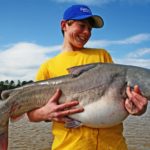
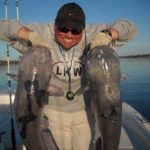
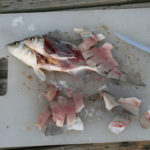
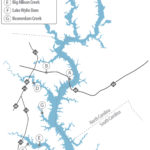
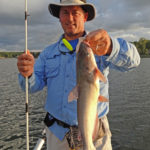

Be the first to comment